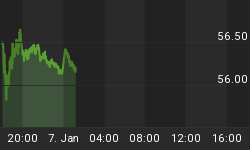This past week the S&P100 options (i.e., the OEX put call ratio) hit an extreme in that the number of puts exceeded the number of calls by a wide margin. The OEX put call ratio is thought to represent the large money or smart money, and with puts exceeding calls, this is being interpreted by some as a sell signal. After all, why would the "smart money" be looking for protection?
Figure 1 shows a weekly graph of S&P500 with the data point in question in the lower panel. The OEX put call ratio is wrapped in trading bands that are set to identify extremes in the data with a look back period of 52 weeks. The current extreme data point is identified in the oval, and we note that the prior extreme coincided with the May 2010 "flash crash". (See the data point inside the box with the red vertical line.) Based upon the prior data point you might conclude that the S&P100 OEX put call ratio is a great tool to have in your trading arsenal. However, looking at the data in it's totality (from 1986 onward), I would conclude that the "smart money" really isn't so smart.
Figure 1. S&P500/ weekly
As always, let's construct a study where we sell short the S&P500 when the indicator in figure 1 is on a sell signal or above the upper trading band. We cover that position when the indicator drops below the upper trading band. The study starts in 1986 and encompasses 76 unique trades or sell signals, when puts were greater than calls to an extreme degree. 40% of the signals resulted in winning trades, and this strategy produced the equity curve in figure 2.
Figure 2. Equity Curve
From 1986 to 1999, following the "smart money" on sell signals was a losing strategy. Of course, this was a bull market and taking prudent action was rarely rewarded. From 1999 to the present, the results were more positive but by no means is this an equity curve that I would want to have nor could I conceive of developing a trading strategy that utilizes this data.
While the prior extremes in the S&P100 OEX Put/ Call ratio coincided with the "flash crash", following this data point, in general, has led to poor results. While this data point is of interest, I would always ask the question: why use something if it doesn't work?
I previously looked at the S&P100 OEX put/ call ratio when the "smart money" was extremely bullish, and I came to the conclusion that it provided little value. At best, it was a good bull market indicator. The results presented in this article are no more encouraging.
I remain bearish for other reasons (click here and here), but the extremes in the S&P100 OEX put/ call data is not one of those reasons.















